 tips-tricks
tips-tricks
5 Signs and Symptoms That Your RAM Is About to Fail

Random Access Memory (RAM) is an essential component of any computer, as it is responsible for storing and managing the data that is being used by the system at any given time. Without enough RAM, your computer will struggle to run multiple programs simultaneously and may experience frequent crashes or freezes. While RAM is generally reliable, it can still fail or become faulty over time.
In this article, we will discuss 5 signs and symptoms that your RAM is about to fail and what you can do to fix the issue.
1. Frequent crashes and freezes
One of the most common symptoms of faulty RAM is frequent crashes and freezes. If your computer is crashing or freezing more often than usual, it could be a sign that your RAM is failing. When RAM is faulty, it can cause data corruption, which can lead to system crashes and freezes. If you are experiencing frequent crashes or freezes, it is important to identify the cause of the issue and take steps to fix it as soon as possible.
2. Blue screen of death (BSOD)
The blue screen of death (BSOD) is another sign that your RAM may be failing. This is a critical error message that appears when the system encounters a problem that it cannot recover from. BSOD errors can be caused by a variety of issues, including faulty RAM. If you see a BSOD error, it is important to take note of the error code and message, as they can help you troubleshoot the issue.
3. Inconsistent or slow performance
Inconsistent or slow performance can also be a sign that your RAM is failing. If your computer is taking longer than usual to start up or perform tasks, or if it is experiencing performance issues such as lag or stuttering, it could be a sign that your RAM is faulty. In some cases, you may also notice that certain programs or tasks are taking longer to load or execute than usual.
4. Error messages or alerts
Error messages or alerts are another common symptom of faulty RAM. These messages may appear when you try to open a program or perform a task, and they can indicate that the system is unable to access the necessary data or resources. If you are seeing error messages or alerts on a regular basis, it could be a sign that your RAM is failing or has become faulty.
5. Physical damage to the RAM module
Finally, physical damage to the RAM module is another sign that your RAM may be failing. This can include visible damage such as cracks or bends in the module, or it can be more subtle, such as corrosion or oxidation. If you notice any physical damage to your RAM module, it is important to replace it as soon as possible to avoid further issues.
If you suspect that your RAM is failing, there are a few steps you can take to troubleshoot the issue and determine the cause. Here are a few things you can try:
- Check for updates: Make sure that you have the latest updates and drivers installed for your operating system and hardware. Outdated software or drivers can cause problems with your RAM.
- Run a memory test: You can use a memory testing tool such as Memtest86 to check for errors or issues with your RAM. Simply boot from the Memtest86 disk or USB drive and let the tool run for a few hours to check for problems.
- Replace the RAM: If you have tried the above steps and are still experiencing issues, it may be necessary to replace the faulty RAM module. Make sure to purchase a compatible RAM module and install it according to the manufacturer's instructions.
In conclusion, RAM is an essential component of any computer, and it’s important to take action as soon as possible. RAM failure can cause a wide range of issues, from slower performance to system crashes. Replacing the RAM is the best way to prevent these issues and ensure that your computer is running optimally. If you’re unsure how to replace your RAM, you should seek professional help. A qualified technician will be able to diagnose the issue and replace the RAM quickly and safely. Acting quickly is key when it comes to RAM failure. The sooner you recognize the signs and symptoms, the sooner you can take action and prevent further issues. By recognizing the signs and symptoms of RAM failure and taking the necessary steps to replace the RAM, you can ensure that your computer is running smoothly and efficiently.
 by Manoj Pradhan
by Manoj Pradhan